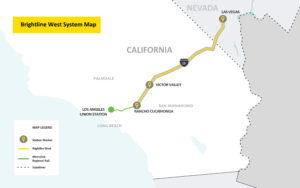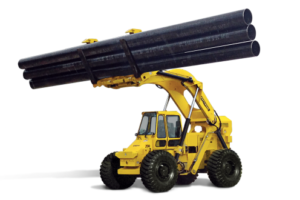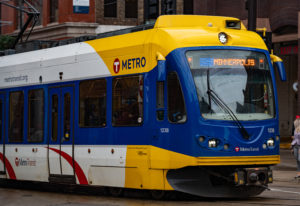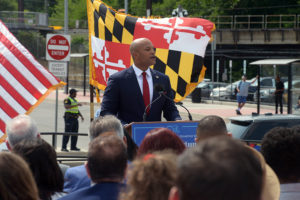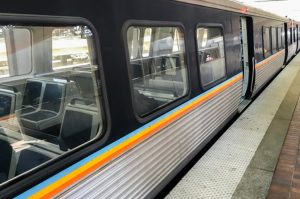Midwest Flooding Recovery: Rollin’ on the river
Written by David C. Lester, Editor-in-Chief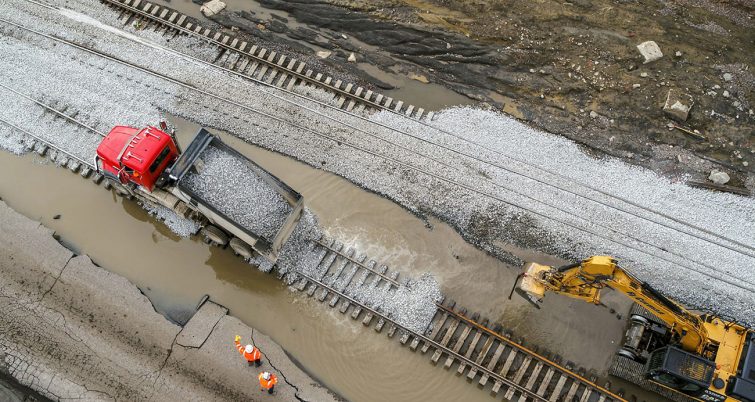
On p 28 of the August issue of this magazine, I quoted Matt Weyand, sales engineer with Ballast Tools Equipment, about the devastation he witnessed while working on track repair for two Class 1 railroads after major flooding in the Midwest this spring. “Events like this are a double-edged sword,” Weyland said. “We’re pleased business is good, but feel terrible for people who have suffered devastating losses from the flooding.
“It’s heartbreaking.”
On May 24, 2019, New York Times reporters Julie Bosman and Manny Fernandez wrote a story about the impact of the flooding on people’s everyday lives. Interviewing some residents in Alton, Ill., the Times report focused in part on the owner of a small business in the downtown area who said, “she has had enough.” The business owner also said “It’s nauseating, to be honest. When you grow up in a river town, you take the river for granted. But now I hate seeing it.” Another resident said “It’s a love-hate thing,” referring to the community’s feelings about the river. Residents enjoy living near the river, but when flooding starts, that enjoyment turns to dread.
Weather and the railroads
While this year’s flooding devastated communities, the railroad industry suffered, too. And, the railroads are no strangers to natural disasters. Massive snowfalls and ice storms can cripple a railroad for days. Even with snow-fighting equipment, it’s still difficult to get trains over the road in harsh winter conditions. In the summertime, roads often suffer from sun kinks, where the rail gets so hot that it buckles. If these kinks are not found soon after they occur, derailments are likely. High winds can blow trains off of the track, particularly double-stack intermodals. Moreover, tornadoes and hurricanes wreak havoc on the rails, as they do with the rest of the community, and it may take weeks to get lines up and running again.
The degree of flooding due to heavy rain we’ve seen this year can easily leave unseen damage behind. Even though a given rail line may look OK on the surface, the layers under the surface may not have drained completely.
This leaves saturated soil, which can cause more problems when trains start running over track that hasn’t been fully evaluated, drained, and cleared for train movement.
Adverse weather events create headaches not only for the railroads but also for their customers. Tight supply chains require regular and on-time deliveries. A significant disruption of rail service weakens the entire supply chain. Containers may not reach U.S. ports in time for ships headed overseas. Even though coal traffic has dropped significantly, electric utilities that still use coal-fired steam plants can see their stockpiles diminish. Perhaps the most nerve-wracking delays are those that involve customers requiring premium intermodal service, such as UPS.
If a train loaded with UPS trailers and containers is even 20 minutes late arriving at its destination, the UPS network suffers.
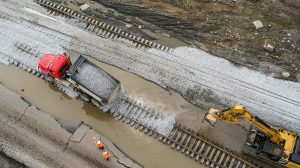
BNSF crews replace ballast following flooding in Nebraska earlier this year.
The massive Midwest flooding also wiped out the crops of some farmers in the region. Railroads haul heavy grain shipments ever year, but if flooding destroys crops, there isn’t as much grain to haul.
At best, this creates a seasonal issue for the farmers and the railroads. At worst, there is the threat of a farmer not able to recover from such a setback. In this case, the farmland doesn’t produce anything until someone can buy it and get crops going again.
Whatever one thinks about climate change, scientists say that the extreme weather events we’ve seen in recent years are exactly what they expect the effects of climate change to be.
And, most agree that we can expect more of the same in coming years.
Weather events tough on short lines
The Dakota & Iowa (D&I), a 110-mile short line that runs from Dell Rapids, S.D., to Sioux City, Iowa, was hit hard this spring. The D&I consists of line owned partially by it’s owner, L.G. Everist, Inc., some trackage rights over BNSF, and about 50 miles owned by South Dakota.
According to retired President and General Manager Jack Parliament, the flooding began on March 15. The railroad had some warning of the flooding, and they had experienced a major flood in 2014. “However, the flood itself was a relatively minor problem at this point, but the ice blockages broke up quickly because of the massive amount of water. This was totally unexpected.” The ice seriously damaged three bridges and completely destroyed one. “Once the bridge was taken out completely, the ice then took out the approach spans.” Parliament told RT&S.
Parliament added that the railroad had some washouts, with the largest being about a mile long. “We had hanging track, and the water took out a culvert.”
“We used rip rap and ballast to shore up the line. Our destroyed bridge lay in the water for about a month, invisible until the water receded. It was a twisted pile of steel that was not salvageable. However, after a lot of hard work, this line was back in service with a new bridge on Aug. 15,” said Parliament.
In addition, one bridge had bents that needed to be replaced, and this took a couple of months to complete. Once this was complete, the line was opened to ethanol facilities and Hudson, S.D.
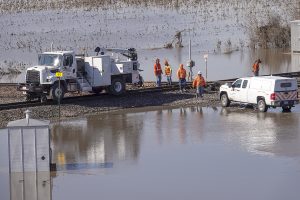
BNSF crews repair flood damage at a rail crossing in Plattsmouth, Neb., on March 22, 2019.
“Fortunately, because we could run trains on the southern end of the railroad, and we made special arrangements for our other customers, none of them had to shut down because of the flooding’s impact on the railroad.”
When asked how he got the railroad back up and running after such a catastrophe, Parliament noted five things that were needed: “Communicate with shippers and let them know what’s going on and what to expect; we received funding from government agencies to help with the rebuild; we got the design for the destroyed bridge done very quickly, and had three sections of 70 ft built; we put in lots of long hours—not 24/7, but sunup to sundown, plus a little; BNSF provided crews for their portion of the track and the track time.”
“Without the support of our shippers and business partners, we could not have achieved the relatively quick recovery,” Parliament noted.
Iowa Northern
The Iowa Northern is a 253-mile short line that runs from Cedar Rapids, Iowa, through Cedar Falls, and up to its Manly Terminal, just east of Mason City. There also is a line in the western part of the state that runs from Forest City to Belmond, and goes to Kanawha over Union Pacific trackage rights. In 2008, the railroad faced a flood so severe that they weren’t sure the road would recover. Even though this occurred 11 years ago, it’s worth looking back at this flood and how the railroad reacted.
“I had never seen a flood of this magnitude,” Dan Sabin, president of the IN, told RT&S. “During late spring, a lot of ground was still frozen. Then, during the last half of May and the entire month of June, we had heavy rain. At that time, our traffic had not been diversified beyond grain haulage. A three-span bridge at Waterloo was lost. Then, a second bridge was lost. Union Pacific had a lot of problems, yet they were able to take detoured Iowa Northern trains, which went on for 18 months.
“All of this just about killed the company. Freight cars were ruined, customers were mad, and the whole thing was a big mess.” Sabin added that it took 18 months to get both bridges replaced.
“Once the water receded, we had a lot of swinging track,” he said.
About 43 miles were washed out, and they hired several companies to bring in rip rap and ballast to rebuild the line. It took about three weeks to get the first revenue trains running again.
Sabin added that the entire situation took a real toll on the employees. It was painful for them to see how much damage a flood could do. They were afraid that the railroad would fail, and everyone put in an extra amount of effort in the work. Union Pacific helped a great deal, and Canadian National helped, too. They went through three months of hell.
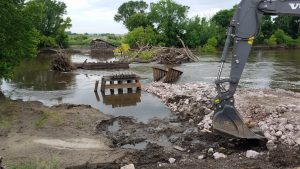
The work begins. Floodwaters on the Dakota & Iowa have started to recede, but there is much to do to replace this bridge and connect it to the mainline.
“We didn’t know what the outcome would be or what the bills would look like,” he said.
Adding insult to injury, Sabin said that their office in downtown Cedar Rapids was flooded, too.
There was a lot of bifurcation on the road, as well.
“Some areas would be washed out, while other areas of the railroad hadn’t been impacted at all,” Sabin said. He added that they were fortunate not to have any employee injuries or fatalities during the restoration process. Their good maintenance of the road paid off when the flood hit.
Sabin also pointed out that all Iowa railroads got strong support from the Governor’s office, and the state DOT was very helpful. The state DOT has been strongly focused on railroads since the 1970s, when the railroads had trouble getting Iowa’s grain shipments to market because of bankruptcies and deferred maintenance. The fortunes of the Rock Island and other granger roads plummeted during those years, and the inability of the state’s roads to move one of Iowa’s key crops caught everyone’s attention. Sabin added, though, “It was good that we didn’t know how long it was going to take to restore the railroad ahead of time, because we may have sold the company.”
Sabin said the state DOT continues to provide a strong level of support today. “The state is with the railroad every step of the way. During our tough winter this past year, the DOT checked in regularly.”
In 2013 and 2015, the railroad had some high water on the bridges, but the repairs from the 2008 floods helped the bridges hold.
“We’re in a far better position to withstand floods today,” Sabin added.
The railroad has replaced about five major bridges since 2008, and Sabin said that if the same flood happened today, they could come back much faster than they did in 2008.
“Our bridges are built much better, business is much stronger today, so we have the funds to have things repaired quickly and properly.”
As most readers know, when the Staggers Act of 1980 established economic deregulation of the railroad industry, major trunk carriers sold many of their branch lines to those who wished to operate a short line railroad. Since those seeds were planted, the short line roads have become a major force in the rail industry, and have increasingly had to deal with “big railroad” problems as they have evolved. The stories in this article are a testament to the grit, guts, and determination demonstrated by most short line owners. As Sabin pointed out during our discussion, when floods come, “Class 1 roads can mobilize people and equipment from other parts of the railroad that weren’t impacted by the flood, and they have the financial resources to ensure that repairs are done correctly.”
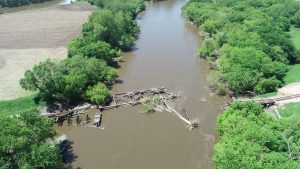
Bridge T-480 lies in the Big Sioux River, just south of Canton, S.D.
For Class 1s to have these financial resources is another benefit of economic deregulation.
This feature story appears in the October issue of RT&S. To view the issue, click here.

